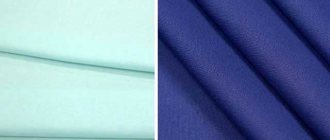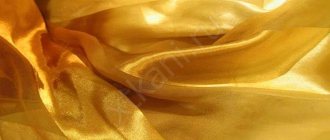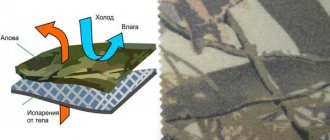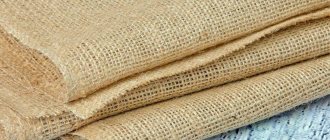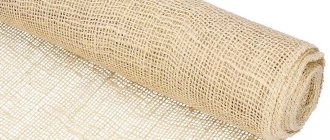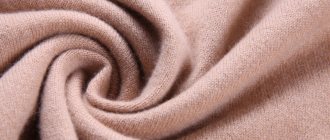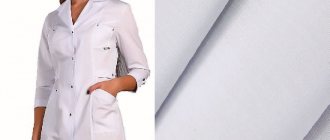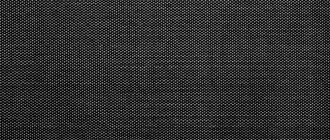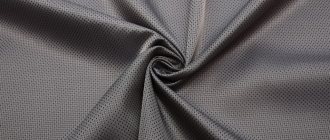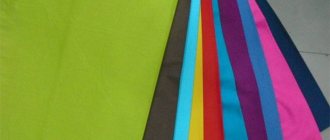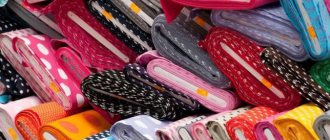Translated from English, the word moleskin means “mole skin”. And, indeed, this name well describes the appearance of moleskine. It is a dense, dark fabric with a glossy sheen.
The material was invented in Great Britain at the beginning of the 20th century, initially used for the production of workwear, and then in other areas of industry. In Russia, the fabric is sometimes called “devil's leather.”
Description of the composition and production process of moleskine
Moleskine is 100% cotton fabric. According to Russian GOST R57877-2017, the inclusion of synthetic fibers is not allowed in its composition. However, foreign companies also produce mixed versions of the material.
The production process includes the following steps:
- Cotton is harvested manually or mechanized.
- The raw materials are kept in storage for a day, then loosened and cleaned of foreign impurities.
- The resulting fibers are twisted and pressed to form thin threads.
- The material is painted. Most manufacturers use dark colors: black, gray, khaki, olive, blue. Bleached fibers and camouflage patterns (flektarn) are also common.
- The threads are woven using the satin method, in which additional overlaps are included in the fabric, reinforcing the bonds between the warp and weft. The result is a very dense fabric.
If the material is intended for sewing workwear, then an additional impregnation is applied to its surface: insulating, water-repellent or fire-resistant. And some manufacturers subject the reverse side of the product to napping to give it greater softness.
Properties and characteristics
Increased fiber density is considered the main characteristic of moleskin material. This feature makes it possible for clothing made from this textile to provide reliable protection of the human body from all kinds of contaminants.
Important! Thanks to the special stylistic weave of the threads, the surface of the finished product is very smooth. It ensures that large particles roll off the front side of the suits. Moleskin fabric can also be impregnated with different compounds to impart special properties and performance.
On the reverse side the material has a slight fleece. It is created due to the tufting of the finished fabric. The fibers of individual threads are pulled out onto the surface of the textile. It is this feature that improves the heat-shielding properties and increases the wear resistance of the product, and also makes the reverse side softer.
Moleskine Blend collection
Moleskine is most often a plain-dyed fabric of one color that does not fade for a long time, wears out little and does not lose its shape at all. Unfortunately, not everyone knows what moleskine is. Some people think that such dense material does not allow the body to breathe. This opinion is erroneous, since it has a cotton base, thanks to which the suit will not be hot even in rooms with high temperatures.
You might be interested in this. Features of felt: what the fabric is made of and what can be sewn from it
"Devil's Skin" has the following unique properties:
- ease of care;
- environmental friendliness;
- high wear resistance;
- mechanical strength;
- dustproof.
Moleskine Blend canvas
Types of Moleskine
Different types of material may have differences in composition and performance characteristics. The table below shows the fabrics that are commercially available.
Table 1. Types of moleskine
| Name | Characteristics | Areas of application |
| S174-SOUTH or S27-UD | Density 250 g/m², additional impregnation for protection against aggressive acids, alkalis, and liquid metal particles | Sewing workwear for workers in the chemical and automotive industries, metallurgy |
| S159-SOUTH or S28-UD | Density 280 g/m², fire-resistant fabric | Sewing workwear for employees of the Ministry of Emergency Situations and other areas related to fire risk |
| S173-SOUTH or S26-UD | Density 347 g/m², increased dust resistance | Sewing workwear for workers of nuclear power plants, public utilities, and the military |
There is another classification: P25 and P29. The first standard means protection from fine dust, the second means fire-resistant and water-resistant impregnation.
Origin of fabric and its features
At the end of the 19th century, along with the explosive growth of industry, especially the chemical industry, with the advent of new high-rise buildings and railways, the problem arose of protecting personnel from fire, dust, metal shavings, and hot drops. What was needed was an inexpensive protective fabric. The British weaving industry responded and produced moleskine, a fabric as a counterweight to thick American denim. The name of the new material was given because of its external similarity with mole skin, which has exactly the same small-segmented facial surface, smooth to the touch.
Interestingly, the Italian brand Moleskine has nothing to do with moles or cotton. But it sounds very similar to moleskin, the name of the fabric.
The USSR quickly realized the potential of the new material; it was produced in large volumes from Uzbek cotton according to special GOST standards. The fabric was used for its intended purpose - to protect people from adverse factors, especially microparticles of various origins.
Main characteristics of moleskin fabric
Like any fabric, moleskin has its advantages and disadvantages. The positive performance characteristics of the material include the following:
- Increased strength . Due to the reinforced satin weave of the threads, moleskin is very difficult to tear.
- Abrasion resistance . According to GOST R57877-2017, moleskin can withstand 2000 friction cycles. Adding a protective impregnation to the composition increases this figure several times. In comparison, regular plain weave cotton fabric will deteriorate after just 1,500 abrasion cycles.
- Dustproof . The material reliably protects the skin from pollution, and some of its varieties from radioactive dust. Since debris does not penetrate deep into the fibers, the fabric is easy to clean and wash.
- Air permeability . This advantage is typical for most natural materials. In cotton clothes, the body “breathes” and a person feels comfortable.
- Hygroscopicity . The fabric absorbs moisture well. This property is important for those who engage in intense exercise and sweat.
- Beautiful appearance . Although the fabric is inexpensive to produce, it looks stylish. Original colors, shapes and glossy shine give moleskin clothing a “zest”.
- Heat resistance . P29 standard material protects the skin from temperature changes and open fire. In addition, the product can be washed in hot water.
- Safety . Cotton is a hypoallergenic material. However, items made from it should be stored in a dry place to prevent the growth of mold.
Moleskine has the same disadvantages as most types of cotton fabrics. During processing it has increased flowability, and when washed it shrinks. In addition, the material is quite hard. It may chafe sensitive skin, especially in the elbow and shoulder areas.
Advantages and disadvantages
Thanks to its natural composition and special weave of threads, moleskin has many advantages.
- Increased strength and wear resistance.
- Absolutely dustproof.
- Long weft overlaps make the surface smooth and shiny.
- Quick and easy cleaning from various contaminants.
- Air permeability and hygroscopicity due to the natural composition of the material.
- The fabric does not accumulate static electricity.
Speaking of disadvantages, we can note the slight friability of the fabric when cutting. In addition, hard material can rub the skin on the folds: knees and elbows.
In what areas is moleskin used?
The main area of application of the material is the production of workwear. Suits are made from moleskin for the following workers:
- nuclear power plants;
- metallurgical enterprises;
- utilities;
- law enforcement agencies: military, internal affairs bodies, Ministry of Emergency Situations;
- oil and gas and automotive industries;
- medical institutions;
- aviation;
- agriculture, forestry, fishing.
Less dense types of fabric are used to make stylish clothes: jackets, jackets, trousers, suits, jackets, raincoats. Moleskin with water-repellent impregnation is used in sewing raincoats, travel equipment, and car covers. In addition, the practical material can be used as a base for artificial leather, book binding, and notepad cover.
Application area
Sewing workwear for people whose professional activities involve hazardous industries is recognized as the main area of use of moleskin material. One cannot do without products made from this fabric:
- Atom stations;
- metallurgical and chemical plants;
- medical institutions;
- utility services.
Since its inception and until now, fire-resistant material has been used to create things for working in hazardous conditions. But despite this, the fabric is also used for sewing spectacular exhibits that are presented at fashion shows. Such clothes, in addition to their attractive and aesthetic appearance, are highly wear-resistant.
Clothes for welders made of moleskin fabric
How to properly care for moleskin products
The fabric is easy to care for. However, to extend the life of products made from it, it is useful to follow the following rules:
- Wash things at a temperature of 40-60°C. Clothes will shrink in hotter water. Washing by hand or in an automatic machine at medium speed is allowed.
- Products with protective impregnation are recommended to be washed with liquid detergents for delicate fabrics. Other types of material are used as ordinary powder. Do not use bleach.
- Dry items vertically, away from the radiator. You can hang them in the sun. Machine drying is not recommended as it can cause shrinkage.
- Iron items with an iron at 150°C or a steamer.
Items can be dry cleaned. It is better to store them folded on the shelves of the closet.
Recommendations for care and instructions for use
In conclusion, let's look at the basic rules of care:
- No special care is required - it can be stored for a long time in a closet, basement, attic, etc. without any problems.
- In case of external contamination, in most cases, to clean it, you just need to shake it or clean it with a vacuum cleaner.
- If the fabric has become very dirty, it must be washed in a washing machine on a standard program, but it is not recommended to heat the water to a temperature above 60 degrees (otherwise the clothes may shrink slightly).
To wash moleskin with special impregnation, it is recommended to resort to dry cleaning, since during normal washing the impregnation is gradually washed out.
Buying moleskin fabric: FAQ
Question. How much does moleskin cost?
Answer. The average price of 1 linear meter of fabric with a density of 250 g/m² (the most common type) is 150-300 rubles.
Question. Which companies produce workwear made from moleskin?
Answer. Nowadays in Russia, items on sale are mainly from domestic and Chinese companies. Good, “Vostok-Service”, “Leon-working clothes”, “Ivspetsposhiv”, Ursus.
Moleskine is a durable, wear-resistant and practical fabric. It can be used by both workers in hazardous industries and ordinary people who want to wear comfortable things. With proper care, clothing will last for many years.
Care
There is nothing difficult about caring for clothes made from moleskin fabric. Follow our recommendations and your items will retain their integrity and attractiveness for a long time.
This material can be washed either by hand or in an automatic machine, and the water temperature should not exceed 60 degrees. For washing, use powder or liquid gel; it is better to wash impregnated fabrics with a mild detergent for delicate care. Bleach and aggressive substances can damage the texture and color of the product.
You can dry moleskin in the traditional way by hanging the product on a clothesline. It is better to avoid drying on heating devices and in a dryer.
Iron clothes of this material with an iron at a temperature not exceeding 150 degrees. This should be done especially carefully if there are synthetics in the moleskin composition.
Moleskin fabric is unique in its properties and versatile in its areas of application, which explains its popularity and demand in the textile market.
Advantages
The advantages of moleskin fabric include its high tensile strength and wear resistance. The material is not afraid of friction. The following advantages distinguish it from others:
- high hygroscopicity;
- excellent breathability;
- ease of cleaning;
- almost 100% dustproof.
The material lends itself well to painting and treatment with special protective compounds. The products retain their attractive appearance for a long time.
Types of material
Moleskine is distinguished by density and type of impregnation, each of which has its own function. There are articles according to GOSTs, which you can use to guide you when choosing functionality.
| vendor code | Density, g/m2 | Purpose |
| From 26 -UD | 340-350 | for industries with fine dust (flour, cement, dyes) |
| From 27 -UD | 250 | for protection against dust, dirt, acids (up to 20%) |
| From 28 –YuD | 280 | for thermo-, fire-retardant impregnations (up to 200 degrees) |
In Europe, moleskin is used as a lining material; medical splints and soundproofing cases are made from it.

